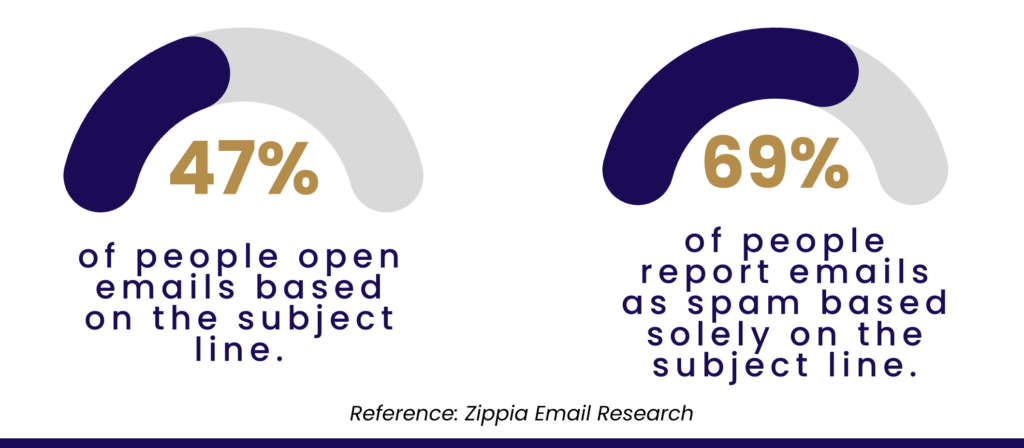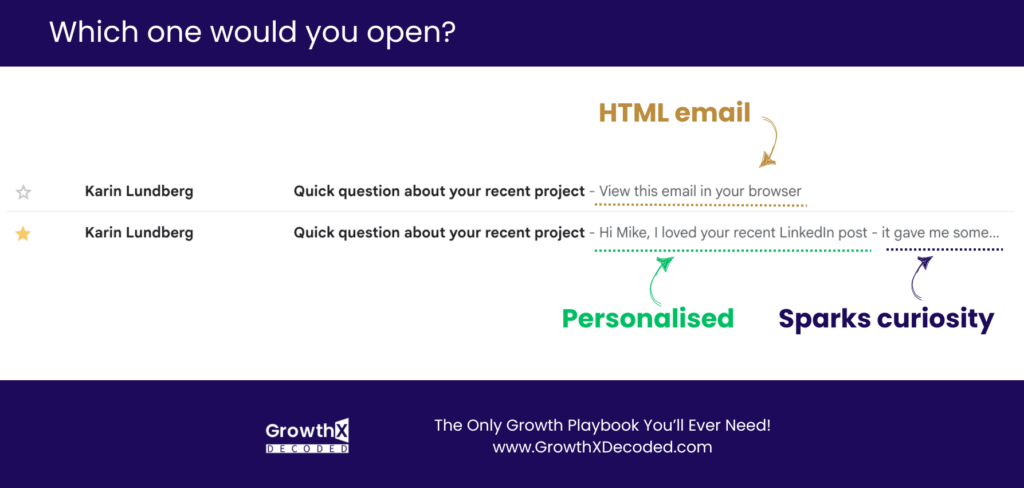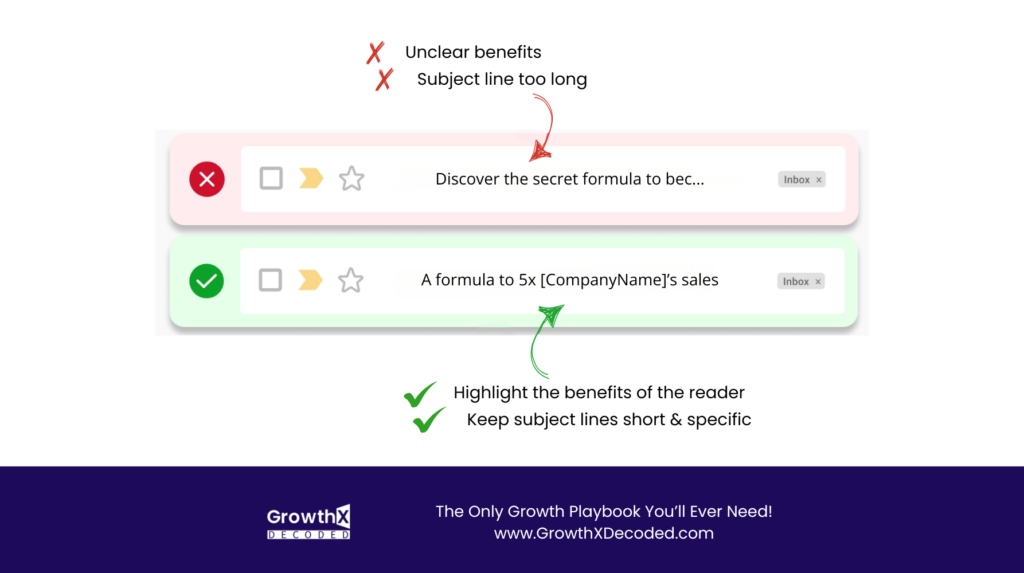How to Write Cold Email Subject Lines That Get Opened
Your cold email is dead on arrival if the subject line isn’t exceptionally great.
It doesn’t matter if the body is pure gold—if it’s never opened, it’s never read. Here’s why:

Before we dive into how to craft subject lines that actually work, keep in mind: writing subject lines for cold emails is very different from writing them for newsletters.
Why? Because you’re dealing with completely different levels of trust and familiarity.
Your first line shows up as preview text—make it personal to instantly hook the reader (first 36 characters are crucial).

Crafting effective cold email subject lines is crucial for capturing your recipient’s attention and encouraging them to open your email. Below are key dos and don’ts to guide you, each accompanied by a brief explanation and an example:
Explanation: Concise subject lines (ideally under 50 characters) are less likely to be truncated, especially on mobile devices, ensuring your message is fully conveyed.

Including the recipient’s name or company makes the email feel tailored—boosting open rates. Here are more smart ways to personalize a subject line:
| Type | Explaination? | Example |
| Name | Add the recipient’s name to make it feel personal. | “John, quick idea for you” |
| Company | Mention their company or job title to make it relevant. | “A formula to 5x Acme’s sales” |
| Industry | Reference their industry to spark curiosity or FOMO. | “New trends in SaaS you should know” |
| Recent activity | Show you follow their updates on LinkedIn or Twitter. | “Saw your recent LinkedIn post—had to reach out” |
| Pain point | Call out a challenge they face—hint you can help. | “Struggling with churn? Here’s a quick fix” |
| Location | Use their city to make it local and relatable. | “This is how a NYC startup you know tripled sales last year” |
| Interaction | Remind them of a recent convo or interaction. | “[Mutual connection] suggested reaching out to you” |
| Shared Hobby | Use common hobbies to break the ice and build rapport. | “As fellow surfers, I thought you’d enjoy this” |
Always write subject lines that spark curiosity—because that’s their only job: get the email opened. If you can find just one angle that makes the reader think “Wait, what’s that about?”, you’ve nailed it. Here are a few idea starters:
• This is how a small startup beat Google • You’ll either love this or hate it • A weird pattern we found in 1,000+ cold emails • Not what you’d expect from a B2B founder • Noticed a broken link on one of your pages
There’s no universal formula for the perfect subject line—what works in one industry might flop in another. That’s why you can’t rely on just a few go-to templates. Instead, make testing a habit and experiment with different styles.
Even small tweaks can dramatically boost open rates. To get the most out of every campaign:
- Write 3–4 subject line variations
- Test them on 10% of your email list (ideally with at least 100 recipients per variation for statistically meaningful results)
- Pick the winner (highest open rate) and send it to the remaining 90% of your list.
Now, the don’ts—or what to avoid when writing your subject line.
Using fake prefixes like “Re:” or “FW:” when there was no reply or forward misleads recipients and often gets your email flagged as spam. Even if it reaches the inbox, people tend to delete it immediately.
The same goes for clickbait subject lines that overpromise or trick the reader—they may get opens, but they destroy trust and can damage your sender reputation.
Bad examples to steer clear of:
• Re: Potential collaboration • FW: Just take a look • Make $10k fast with this tip
Certain words and formats can trigger spam filters and send your email straight to the junk folder. Even if it lands in the inbox, a subject line that sounds overly sales-y can instantly kill your credibility.
Instead, aim for a natural, conversational tone—something that feels like it’s coming from a real person, not a sales machine.
Here’s a list of 30 spam trigger words you should avoid in your email subject:
Congratulations! | 100% Free | No fees | Win – Click now | Make money | LIMITED TIME! | Act now | Call now | You’re a winner | Not spam | Get paid | No cost | Work from home | Get started free | Increase sales | About to expire | Unlimited | Join millions | Satisfaction guaranteed | Claim | Guaranteed | Risk-free | Free gift | Best price | Bonus | Earn extra cash | Exclusive deal | Double your income | This isn’t a scam | Order now
Subject lines written in ALL CAPS don’t grab attention—they just scream spam. Most spam filters are trained to flag these kinds of emails, even when the content is valuable.
Avoid subject lines like:
• ACTION REQUIRED IMMEDIATELY
• LIMITED TIME: Don’t miss this!
• You need to see this NOW!!!Exclamation marks can hurt you too. A study of 115 million emails found that subject lines with even one had a lower open rate (45%) compared to those without (51.9%). Keep it natural.
Some senders use vague subject lines to spark curiosity—but they usually fall flat, especially with busy people (most of us are, isn’t it?).
Lines like “Got a question for you” give no real value and often feel spammy coming from strangers.
Curiosity is great—but be clear about what’s inside.
Avoid:
• Check this out
• Quick question
• Website inquiry
• Thought?
• Following upJumping straight into a request—without context or value—can feel abrupt and self-serving. Subject lines like “Let’s hop on a call” or “I need a post on your site” turn people off, especially if they don’t know who you are.
Avoid these:
• Request to connect • I need a post on your website • Let's catch up soon • Quick chat? • Let's hop on the phone • Do you have 5 minutes to spare?
Subject lines are absolutely critical to the success of your cold emails—if they don’t spark interest, your message won’t even get opened. That’s why it’s essential to follow the principles above and continuously test different subject lines to see what resonates best with your audience.
If you’re ready to start working on other parts of your cold email campaign, here’s the full guide to doing it right—and running a successful outreach that gets replies.